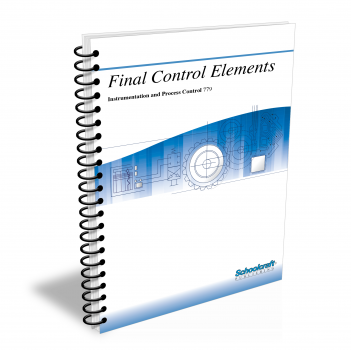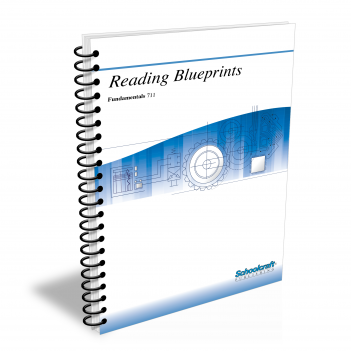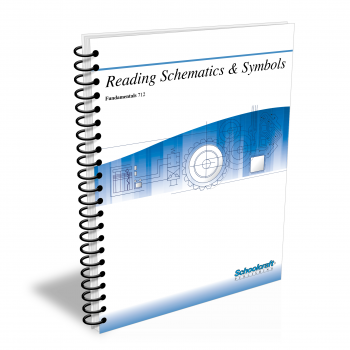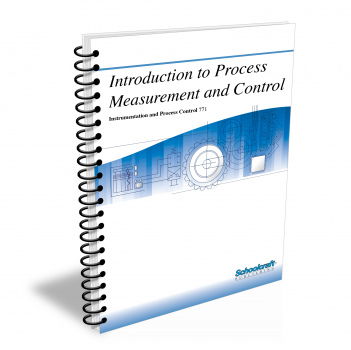Final Control Elements

Course Number: 779
The Final Control Elements textbook explains how elements in a closed-loop system affect final control element and describes components in a final control subsystem. It discusses the operation of solenoids, motors, relay systems, and PLCs. It explains how pneumatic actuators and positioners work and describes mechanical advantage in several hydraulic control systems. It compares construction, characteristics, and applications of eight kinds of control valves. Finally, it traces the operation of each element in typical feedwater, turbine, and robotic control systems.
Does your curriculum require additional topics not included in this textbook? Build a customized version of the Final Control Elements textbook below.
This textbook has been recently updated
to include topics lists, objectives, & key terms for every chapter.
Recommended Contact Hours – 8
Preview a Chapter
Available Supporting Material
- Table of Contents
- Exam Copies
- Suggested Titles
Table of Contents
Chapter 1: Final Control Elements in Process Loops
Topics: Compensation; Feedback loops; Performance effects of disturbances; Final control subsystem parts; Amplifiers; Digital signals
Learning Objectives:
- Discuss the function of final control elements in process loops.
- Explain how an actuator is used with the final control element.
- Discuss the effect of a disturbance on the performance of a process loop.
- Describe the three parts of a final control element subsystem.
- Discuss the differences between electric and fluidic control signals in the operation of final control elements.
Chapter 2: Electric Actuators
Topics: Solenoids; Solenoid-operated valves; DC and AC motors; Three-phase and single-phase induction motors; Stepper motors; Relay systems; PLCs
Learning Objectives:
- Describe the operation of a solenoid with a valve.
- Name the basic components of dc and ac electric motors and explain how they work.
- Discuss the advantages of universal motors and stepper motors.
- Explain how an electromechanical relay works.
- Name at least three kinds of relays in use today and give typical applications for them.
- Discuss the applications and advantages of programmable logic controllers.
Chapter 3: Pneumatic and Hydraulic Actuators
Topics: Effects of changing pressure and temperature; Diaphragm, piston and hydraulic actuators; Mechanical advantage; One- and two-way systems
Learning Objectives:
- Describe the basic principles of operation for both pneumatic and hydraulic actuators.
- Discuss the relationships among pressure, temperature, and volume in a pneumatic system.
- Compare the operation of direct- and reverse-acting actuators.
- Describe the major components of a simple hydraulic system.
- Discuss the characteristics of proper hydraulic fluid and describe elements of hydraulic system maintenance.
Chapter 4: Control Valves
Topics: Valve components and characteristics; Globe, cage, butterfly, ball, sliding-gate, diaphragm, split-body, proportional/servo, and other valves
Learning Objectives:
- Describe the components of a control valve.
- Compare the operation and advantages of globe, cage, butterfly, ball, sliding-gate, diaphragm, and split-body valves.
- Discuss the operation, advantages, and disadvantages of proportional/servo valves.
- Explain the differences in linear, quick-opening, and equal-percentage flow characteristics.
- Discuss mechanical requirements for valves and valve actuator requirements.
- Explain the relationship of flashing and cavitation to proper control valve selection.
Chapter 5: Final Control Element Applications
Topics: Feedwater and turbine control systems; Sequential and automatic valve control; Control and block valves; Robotic systems
Learning Objectives:
- Describe the sequential valve control used in a typical feedwater control system.
- Describe a typical relay logic system.
- Discuss the use of limit switches for automatic valve control.
- -Describe the operation of a hydraulic fluid supply system for a turbine generator.
- Describe the operation of an industrial robotic system.
Request Exam Copies
Exam Copies
Ready to see a copy of our textbooks? After selecting which textbooks you’d like to review for your course, you can submit your request by either logging in or creating an account so we know where to ship your exam copies. A representative from Schoolcraft will contact you to confirm and finish processing your request.
Exam copies are always free and yours to keep.
Selected Exam Copies
none selected
* Maximum of five copies can be ordered


